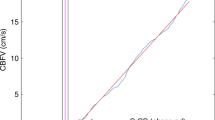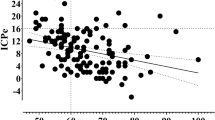Abstract
It is important to monitor cerebral perfusion in infants because hypo- and hyperperfusion can contribute to neurological injury. This study aimed to clarify the relationship between trans-systolic time (TST) and critical closing pressure (CrCP) or estimated cerebral perfusion pressure (CPPe) in neonates. Moreover, we aimed to determine the TST values in preterm and term infants with stable cerebral perfusion to clarify normative reference data. This multicentre prospective study included infants with arterial lines admitted to the neonatal intensive care units between December 2021 and August 2023. TST, CrCP, and CPPe were calculated using middle cerebral artery waveforms recorded using transcranial Doppler ultrasonography when clinicians collected arterial blood samples. Three hundred and sixty samples were obtained from 112 infants with a gestational age of 32 (interquartile range, 27–37) weeks and a birth weight of 1481 (956–2355) g. TST was positively correlated with CPPe (r = 0.60, p < 0.001), but not with CrCP (r = 0.08, p = 0.10). The normative reference values of TST in preterm and term infants without samples of hyper- or hypocapnia and/or hyper- or hypotension, which may affect cerebral perfusion, were as follows: ≤ 29 weeks, 0.12 (0.11–0.14) s; 30–36 weeks, 0.14 (0.12–0.15) s; and ≥ 37 weeks, 0.16 (0.14–0.17) s, respectively.
Conclusion: TST in neonates significantly correlated with CPPe, but not with CrCP. TST may be a good predictor of cerebral perfusion and potentially have wider clinical applications.
What is Known: • Trans-systolic time (TST) is used in evaluating the effects of increased intracranial pressure on cerebral haemodynamics. However, little is known about the efficacy of TST in predicting neonatal cerebral perfusion pressure. | |
What is New: • This study added evidence that TST correlated with estimated cerebral perfusion pressure, but not with critical closing pressure. Additionally, we showed the normative reference values of the TST in preterm and term infants. |





Similar content being viewed by others
Data availability
No datasets were generated or analysed during the current study.
Abbreviations
- ABP:
-
Arterial blood pressure
- CBF:
-
Cerebral blood flow
- CPP:
-
Cerebral perfusion pressure
- CPPe:
-
Estimated cerebral perfusion pressure
- CrCP:
-
Critical closing pressure
- CRIB:
-
Clinical risk index for babies
- FVd:
-
Diastolic flow velocity
- FVs:
-
Systolic flow velocity
- ICP:
-
Intracranial pressure
- MAP:
-
Mean arterial blood pressure
- NICU:
-
Neonatal intensive care unit
- PaCO2 :
-
Partial pressure of carbon dioxide
- PI:
-
Pulsatility index
- RI:
-
Resistance index
- ROC:
-
Receiver operating characteristic curve
- SPECT:
-
Single-photon emission computed tomography
- TCD:
-
Transcranial Doppler
- TST:
-
Trans-systolic time
References
Rhee CJ, da Costa CS, Austin T, Brady KM, Czosnyka M, Lee JK (2018) Neonatal cerebrovascular autoregulation. Pediatr Res 84:602–610. https://doi.org/10.1038/s41390-018-0141-6
Burton AC (1951) On the physical equilibrium of small blood vessels. Am J Phys 164:319–329. https://doi.org/10.1152/ajplegacy.1951.164.2.319
Varsos GV, Kolias AG, Smielewski P, Brady KM, Garsos VG, Hutchinson PJ, Pickard JD, Czosnyka M (2015) A noninvasive estimation of cerebral perfusion pressure using critical closing pressure. J Neurosurg 123:638–648. https://doi.org/10.3171/2014.10
Rhee CJ, Fraser CD 3rd, Kibler K, Easley RB, Anropolos DB, Czosnyka M, Varsos GV, Smielewski P, Rusin CG, Brady KM, Kaiser JR (2015) Ontogeny of critical closing pressure. Pediatr Res 78:71–75. https://doi.org/10.1038/pr.2015.67
Kim ES, Kaiser JR, Rios DR, Bornemeier RA, Rhee CJ (2020) Cerebral hemodynamics are not affected by the size of the patent ductus arteriosus. Neonatology 117:182–188. https://doi.org/10.1159/000506835
Rhee CJ, Kibler KK, Easley RB, Andropoulos DB, Czosnyka M, Smielewski P, Varsos GV, Brady KM, Rusin CG, Fraser CD 3rd, Gauss CH, Williams DK, Kaiser JR (2016) The diastolic closing margin is associated with intraventricular hemorrhage in premature infants. Acta Neurochir Suppl 122:147–150. https://doi.org/10.1007/978-3-319-22533-3_30
Hanlo PW, Peters RJ, Gooskens RH, Heethaar RM, Keunen RW, van Huffelen AC, Tulleken CA, Willemse J (1995) Monitoring intracranial dynamics by transcranial Doppler–a new Doppler index: trans systolic time. Ultrasound Med Biol 21:613–621. https://doi.org/10.1016/0301-5629(94)00147-6
Jarmund AH, Pedersen SA, Torp H, Dudink J, Nyrnes SA (2023) A scoping review of cerebral Doppler arterial waveforms in infants. Ultrasound Med Biol 49:919–936. https://doi.org/10.1016/j.ultrasmedbio.2022.12.007
Parry G, Tucker J, Tarnow-Mordi W, UK Neonatal Staffing Study Collaborative Group (2003) CRIBII: an update of the clnical risk index for babies score. Lancet 36:1789–1791. https://doi.org/10.1016/S0140-6736(03)13397-1
Schmidt EA, Czosnyka M, Gooskens I, Piechnik SK, Matta BF, Whitfield PC, Pickard JD (2001) Preliminary experience of the estimation of cerebral perfusion pressure using transcranial Doppler ultrasonography. J Neurol Neurosurg Psychiatry 70:198–204. https://doi.org/10.1136/jnnp.70.2.198
Smielewski P, Czosnyka M, Kirkpatrick P, McEroy H, Rutkowska H, Pickard JD (1996) Assessment of cerebral autoregulation using carotid artery compression. Stroke 27:2197203. https://doi.org/10.1161/01.str.27.12.2197
Panerai RB, Kelsall AW, Rennie JM, Evans DH (1995) Estimation of critical closing pressure in the cerebral circulation of newborns. Neuropediatrics 26:168–173. https://doi.org/10.1055/s-2007-979748
Brian JE Jr (1998) Carbon dioxide and the cerebral circulation. Anesthesiology 88:1365–1386. https://doi.org/10.1097/00000542-199805000-00029
Cold GE (1990) Cerebral blood flow in acute head injury. The regulation of cerebral blood flow and metabolism during the acute phase of head injury, and its significance for therapy. Acta Neurochir Suppl (Wien) 49:1–64
Liu J, Li J, Qin GL, Chen YH, Wang Q (2008) Periventricular leukomalacia in premature infants in mainland China. Am J Perinatol 25:535–540. https://doi.org/10.1055/s-0028-1083841
Zayek MM, Alrifai W, Whitehurst RM Jr, Kua KL, Martino A, Eyal FG (2014) Acidemia versus hypercapnia and risk for severe intraventricular hemorrhage. Am J Perinatol 31:345–352. https://doi.org/10.1055/s-0033-1349896
Dionne JM, Cl A, Flynn JT (2012) Hypertension in infancy: diagnosis, management and outcome. Pediatr Nephrol 27:17–32. https://doi.org/10.1007/s00467-010-1755-z
Mostbeck GH, Gossinger HF, Mallek R, Siostrzonek P, Schneider B, Tscholakoff D (1990) Effect of heart rate on Doppler measurements of resistive index in renal arteries. Radiology 175:511–513. https://doi.org/10.1148/radiology.175.2.2183288
Baranger J, Villemain O, Wagner M, Vargas-Gutierrez M, Seed M, Baud O, Ertl-Wagner B, Aguet J (2021) Brain perfusion imaging in neonates. Neuroimage Clin 31:102756. https://doi.org/10.1016/j.nicl.2021.102756
Spaeder MC, Surma VJ (2021) Cerebral regional oxygen saturation variability in neonates following cardiac surgery. Pediatr Res 90:815–818. https://doi.org/10.1038/s41390-020-01171-1
Pereira SS, Sinha AK, Shah DK, Kempley ST (2021) Common carotid artery blood flow volume in extremely preterm infants. Acta Paediatr 110:1157–1165. https://doi.org/10.1111/apa.15655
Sinha AK, Cane C, Kempley ST (2006) Blood flow in the common carotid artery in term and preterm infants: reproducibility and relation to cardiac output. Arch Dis Child Fetal Neonatal Ed 91:F31–F35. https://doi.org/10.1136/adc.2004.058172
Dempsey EM, Barrington KJ (2006) Diagnostic criteria and therapeutic interventions for the hypotensive very low birth weight infant. J Perinatol 26:677–681. https://doi.org/10.1038/sj.jp.7211579
Levene M, Chiswick M, Field D, Forsyth S, Gamsu H, Grant A (1992) Development of audit measures and guidelines for good practice in the management of neonatal respiratory distress syndrome. Report of a Joint Working Group of the British Association of Perinatal Medicine and the Research Unit of the Royal College of Physicians. Arch Dis Child 67:1221–1227. https://doi.org/10.1136/adc.67.10_spec_no.1221
Michel E, Hillebrand S, vonTwickel J, Zernikow B, Jorch G (1997) Frequency dependence of cerebrovascular impedance in preterm neonates: a different view on critical closing pressure. J Cereb Blood Flow Metab 17:1127–1131. https://doi.org/10.1097/00004647-199710000-00015
Varsos GV, Richards H, Kasprowicz M, Budohoski KP, Brady KM, Reinhard M, Avolio A, Smielewski P, Pickard JD, Czosnyka M (2013) Critical closing pressure determined with a model of cerebrovascular impedance. J Cereb Blood Flow Metab 33:235–243. https://doi.org/10.1038/jcbfm.2012.161
Robba C, Poole D, McNett M et al (2020) Mechanical ventilation in patients with acute brain injury: recommendations of the European Society of Intensive Care Medicine consensus. Intensive Care Med 46:2397–2410. https://doi.org/10.1007/s00134-020-06283-0
Robba C, Ball L, Nogas S, Battaglini D, Messina A, Brunetti L, Minetti G, Castellan L, Rocco PRM, Pelosi P (2021) Effects of positive end-expiratory pressure on lung recruitment, respiratory mechanics, and intracranial pressure in mechanically ventilated brain-injured patients. Front Physiol 12:711273. https://doi.org/10.3389/fphys.2021.711273
Roberts DJ, Hall RI, Kramer AH, Robertson HL, Gallagher CN, Zygun DA (2011) Sedation for critically ill adults with severe traumatic brain injury: a systematic review of randomized controlled trials. Crit Care Med 39:2743–2751. https://doi.org/10.1097/CCM.0b013e318228236f
Pfister D, Strebel SP, Steiner LA (2008) Effects of catecholamines on cerebral blood vessels in patients with traumatic brain injury. Eur J Anaesthesiol Suppl 42:98–103. https://doi.org/10.1017/S0265021507003407
Acknowledgements
We would like to express our appreciation to the nurses and other healthcare professionals for providing and caring for the patients.
Funding
This study was supported by the JSPS KAKENHI (grant number 23K14985).
Author information
Authors and Affiliations
Contributions
M.Z. designed and performed the experiments. M.O. and E.I. contributed to the data collection. M.Z. wrote the initial draft of the manuscript. N.F., D.U, M.U., A.Y., H.M., K.H., D.K., T.H., T.I. contributed to interpretation and critically reviewed the manuscript. All authors approved the final version of the manuscript and shared accountability for all aspects of the work to ensure that questions related to the accuracy or integrity of any part of the work were appropriately investigated and resolved.
Corresponding author
Ethics declarations
Ethics approval
The study protocol was reviewed and approved by the Clinical Ethics Committee of the University Hospital, Kyoto Prefectural University of Medicine (approval number: ERB-C-2426). Research was carried out in line with the principles of the Declaration of Helsinki.
Consent to participate
This study was designed and received ethical approval to use opt-out consent for all eligible infants born in the participating units. The parents of eligible infants were offered the opportunity to opt out of their infants’ data for inclusion in this study.
Competing interests
The authors declare no competing interests.
STROBE statement
The authors have read the STROBE statement checklist of items, and the manuscript was prepared in accordance with this statement and checklist.
Additional information
Communicated by Daniele De Luca
Publisher's Note
Springer Nature remains neutral with regard to jurisdictional claims in published maps and institutional affiliations.
Rights and permissions
Springer Nature or its licensor (e.g. a society or other partner) holds exclusive rights to this article under a publishing agreement with the author(s) or other rightsholder(s); author self-archiving of the accepted manuscript version of this article is solely governed by the terms of such publishing agreement and applicable law.
About this article
Cite this article
Zuiki, M., Ohta, M., Fujita, N. et al. The prediction of estimated cerebral perfusion pressure with trans-systolic time in preterm and term infants. Eur J Pediatr (2024). https://doi.org/10.1007/s00431-024-05511-9
Received:
Revised:
Accepted:
Published:
DOI: https://doi.org/10.1007/s00431-024-05511-9




